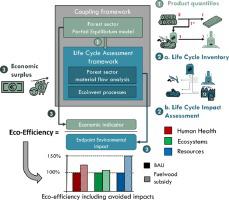Resources, Conservation and Recycling ( IF 11.2 ) Pub Date : 2021-11-22 , DOI: 10.1016/j.resconrec.2021.106024 T. Beaussier 1, 2, 3, 4 , S. Caurla 2, 5 , V. Bellon-Maurel 3, 4 , P Delacote 2, 6 , E. Loiseau 3, 4

|
An innovative modelling framework and metrics are developed to assess the economic and environmental performances of regional incentives in the wood energy sector. Our approach is based on the coupling between a partial equilibrium economic model of the forest sector with Life Cycle Assessment (LCA). Its originality relies on the computation of regional eco-efficiency ratios while taking account of diverse direct and indirect spatial and market interactions. Several adaptations were implemented to ensure consistency between the two modelling approaches in terms of process yields and flow balances. These adaptations make it possible to produce both economic and environmental indicators with a consistent perimeter. Finally, we used two kinds of eco-efficiency indicators to compare bioenergy policies. On the one hand, Partial Eco-Efficiency (PEE) combines the economic surplus induced by an incentive on the energy wood sector with its potential environmental impacts. On the other hand, Full Eco-Efficiency (FEE) adds the environmental impacts avoided by substitution between wood-energy and fossil fuels, compared to a business-as-usual (BAU) scenario. The proposed adaptations were applied to a case study in the French Grand Est region that compared the eco-efficiency of scenarios with or without a subsidy to wood energy consumption. Results show that subsidy increases the eco-efficiency of the forest-based sector using both PEE and FEE while keeping competition with the other regions to a minimum. However, most benefits come from the consideration of avoided impacts, with FEE far exceeding PEE. Using FEE, the scenario with the subsidy is 5% to 50% more eco-efficient than the BAU despite an increased consumption of wood products, due to economic gains and avoided impacts. These outcomes show the importance of considering potential trade-offs when assessing the economic and environmental performance of regional policies in favour of the bioeconomy.
中文翻译:

通过部分平衡模型深化领土生命周期评估方法:从应用到法国地区木材能源激励的初步见解
开发了一个创新的建模框架和指标来评估木材能源部门区域激励措施的经济和环境绩效。我们的方法基于森林部门的部分均衡经济模型与生命周期评估 (LCA) 之间的耦合。它的独创性依赖于区域生态效率比的计算,同时考虑到各种直接和间接的空间和市场相互作用。实施了多项调整,以确保两种建模方法在过程产量和流量平衡方面的一致性。这些调整使生成具有一致边界的经济和环境指标成为可能。最后,我们使用两种生态效率指标来比较生物能源政策。一方面,部分生态效率 (PEE) 将能源木材行业的激励措施引起的经济盈余与其潜在的环境影响相结合。另一方面,与一切照旧 (BAU) 情景相比,完全生态效率 (FEE) 增加了通过替代木材能源和化石燃料避免的环境影响。拟议的调整被应用于法国大东部地区的一个案例研究,该研究比较了有或没有木材能源消耗补贴的情景的生态效率。结果表明,补贴提高了使用 PEE 和 FEE 的森林部门的生态效率,同时将与其他地区的竞争降至最低。然而,大多数收益来自对避免影响的考虑,FEE 远远超过 PEE。使用费用,尽管由于经济收益和避免的影响而增加了木材产品的消费,但补贴方案的生态效率比 BAU 高 5% 到 50%。这些结果表明在评估有利于生物经济的区域政策的经济和环境绩效时考虑潜在权衡的重要性。











































 京公网安备 11010802027423号
京公网安备 11010802027423号